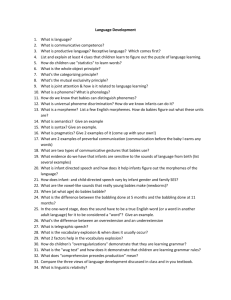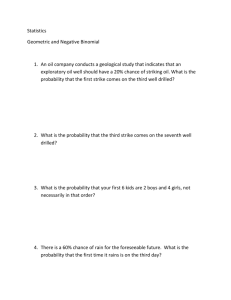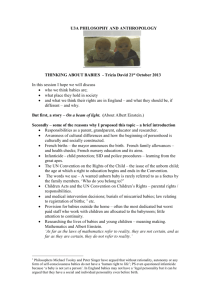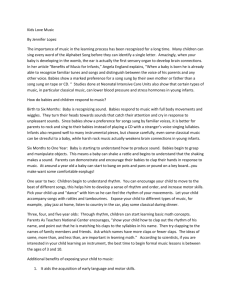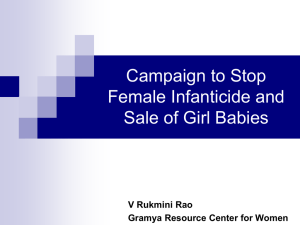From: http://www
advertisement
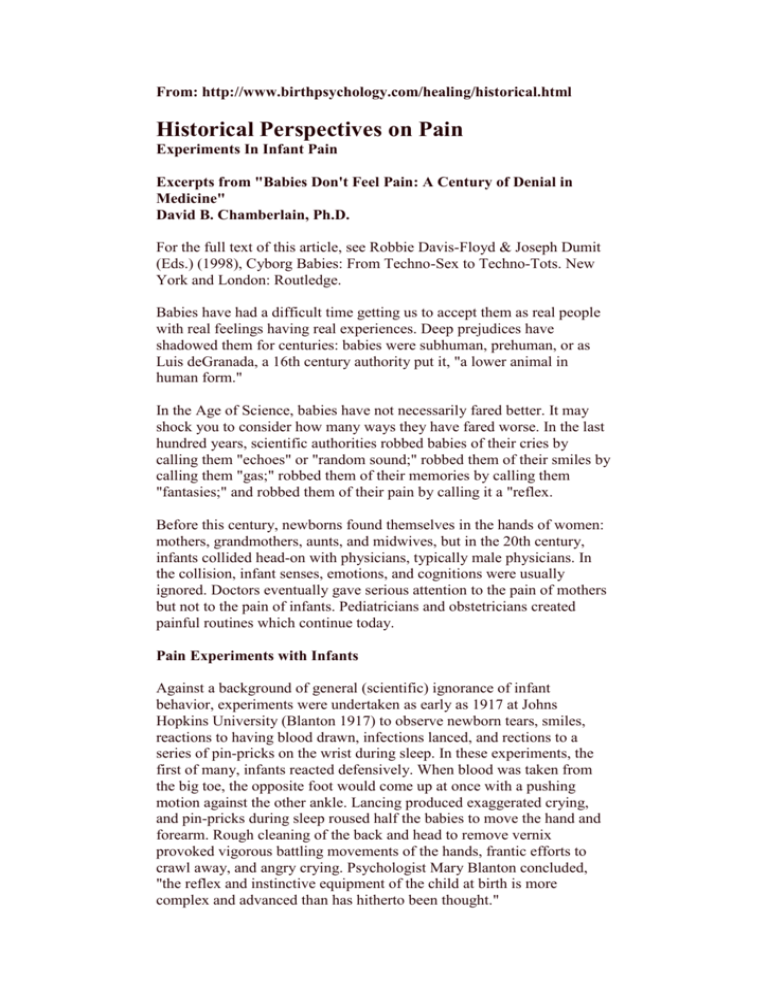
From: http://www.birthpsychology.com/healing/historical.html Historical Perspectives on Pain Experiments In Infant Pain Excerpts from "Babies Don't Feel Pain: A Century of Denial in Medicine" David B. Chamberlain, Ph.D. For the full text of this article, see Robbie Davis-Floyd & Joseph Dumit (Eds.) (1998), Cyborg Babies: From Techno-Sex to Techno-Tots. New York and London: Routledge. Babies have had a difficult time getting us to accept them as real people with real feelings having real experiences. Deep prejudices have shadowed them for centuries: babies were subhuman, prehuman, or as Luis deGranada, a 16th century authority put it, "a lower animal in human form." In the Age of Science, babies have not necessarily fared better. It may shock you to consider how many ways they have fared worse. In the last hundred years, scientific authorities robbed babies of their cries by calling them "echoes" or "random sound;" robbed them of their smiles by calling them "gas;" robbed them of their memories by calling them "fantasies;" and robbed them of their pain by calling it a "reflex. Before this century, newborns found themselves in the hands of women: mothers, grandmothers, aunts, and midwives, but in the 20th century, infants collided head-on with physicians, typically male physicians. In the collision, infant senses, emotions, and cognitions were usually ignored. Doctors eventually gave serious attention to the pain of mothers but not to the pain of infants. Pediatricians and obstetricians created painful routines which continue today. Pain Experiments with Infants Against a background of general (scientific) ignorance of infant behavior, experiments were undertaken as early as 1917 at Johns Hopkins University (Blanton 1917) to observe newborn tears, smiles, reactions to having blood drawn, infections lanced, and rections to a series of pin-pricks on the wrist during sleep. In these experiments, the first of many, infants reacted defensively. When blood was taken from the big toe, the opposite foot would come up at once with a pushing motion against the other ankle. Lancing produced exaggerated crying, and pin-pricks during sleep roused half the babies to move the hand and forearm. Rough cleaning of the back and head to remove vernix provoked vigorous battling movements of the hands, frantic efforts to crawl away, and angry crying. Psychologist Mary Blanton concluded, "the reflex and instinctive equipment of the child at birth is more complex and advanced than has hitherto been thought." Although these results were unequivocal, this line of experimentation continued at Northwestern University and Chicago's Lying-In Hospital (Sherman and Sherman 1925; Sherman et al. 1936) where newborns were stuck with needles on the cheeks, thighs, and calves. Virtually all infants reacted during the first hours and first day after birth, but the trend, researchers noted, was toward more reaction to less stimulation from day one through day twelve. This finding suggested that at birth, newborns were not very sensitive but gradually became more sensitive. What the Shermans failed to tell us was that all mothers in the study had received anesthetic drugs during labor and delivery. They took no account of the effect on the babies. For the missing information, we are indebted to psychologist Daphne Maurer (Maurer and Maurer 1988: 40.) The Shermans discovered that infants would cry in reaction to hunger, to being dropped 2-3 feet and caught, to having their heads restrained with firm pressure, or to someone pressing on their chins for 30 seconds (Sherman 1927; Sherman et al. 1936.) Babies tried to escape and made defensive movements of the arms and legs, including striking at objects to push them away. Today, we would interpret these behaviors as "selfmanagement" or "kinesthetic intelligence," but in those days experts argued about whether the headend or the tail end of a human baby was more sensitive (Sherman et al. 1936:33.) Subsequent studies to learn how infants would react were directed at the big toe (Lipsitt and Levy 1959), calf (Kaye and Lipsitt 1964), head, trunk, and upper and lower extremities. Especially influential was an ambitious study by Myrtle McGraw (1941) at Columbia University and The Babies' Hospital, New York, using pin pricks to reveal the "progressive maturation of nerves." Seventy-five infants were stimulated with a blunt sterile safety pin at intervals from birth to four years of age, and their responses duly recorded. Half were recorded on the new medium of motion picture film. Ten pricks in each area (head, trunk, upper and lower extremities) ensured that reactions were sufficiently "intense." Again, the influence of anesthesia on infant pain perception was overlooked. After 2,000 observations, McGraw reported that some infants a few hours or days old showed no response to pin-prick. The usual response, she said, "consists of diffuse bodily movements accompanied by crying, and possibly a local reflex." In spite of the fact these babies cried and tried to withdraw their limbs, McGraw concluded there was only limited sensitivity to pain and labeled the first week to ten days after birth as a period of "hypesthesia" (abnormally weak sense of pain, heat, cold, or touch). Her reference to a "local reflex" reflected the common medical view that reactions were mechanical and had no mental or emotional component. She asserted that the neonate could in no way localize or identify the source of painful stimulation because the cerebral cortex was not sufficiently developed to permit it. To physicians, McGraw's work seemed so thoroughly scientific that it justified the continuance of painful practices with infants. The belief that newborns were somehow not yet sensitive to pain was a prejudiced interpretation which fit comfortably into the medical view expressed in journals reaching back into the 19th century (Bigelow 1848; Pierson 1852). More recent research shows that newborns and older babies pinched on the arm react instantly to pain (Thoden and Koivisto 1980), with no sign of "hypesthesia." But there were more pin-prick experiments. In 1974, apparently ignorant of the experiments already performed, Rich et al. tested 124 full-term newborns to determine the "normal response" to a succession of pinpricks around the knee. The doctors concluded that "the normal response is movement of the upper and lower limbs usually accompanied by grimace and/or cry." All infants demonstrated the "complete" response after six or fewer pin-pricks. A different method for studying infant pain was to run water of different temperatures through cylinders attached to the baby's abdomen, leg, or forehead while observing reactions as the water was made hotter or colder. This line of research began in Europe in 1873 and was taken up in America by Pratt, Nelson, and Sun at Ohio State University (1930) and by Crudden at the University of Michigan Hospital in 1937. Babies reacted violently, especially to cold water. Crudden found that any deviation from normal body temperature provoked immediate respiratory and circulation changes in all subjects. (No sign of "hypesthesia" here either.) Pain, The Unrecognized Trauma In spite of these experiments with infant pain, the psychological and medical communities never became concerned about it because of the dogma that the brain was too immature to permit babies to comprehend and experience it. Do babies experience pain? Of course they do. (Mothers and fathers know this; it is the professinals who cannot accept it.) Babies express pain quite clearly--even dramatically--through crying. It seems obvious, but experts decided that crying was not meaningful communication: it was described as random sound, or reflexes. They show by characteristic facial expressions how they feel. Body movements demonstrate a frantic discomfort, struggling, squirming, trying to get away. Vital signs confirm that the system of the baby is in an uproar, with heart racing, respiration galloping. Hormonal changes confirm the stress alarm: cortisol and beta endorphin streaming into the blood stream and saliva. Not that we need them to prove pain, but neurobehavioral observations confirm how much the pain disturbs behavior. Normal sleep cycles can go into reverse. Seizuring, tremoring, spitting up, trunk arching, finger-splaying, fisting, and refusing consolation are just some of the specific measures which manifest the reality of pain. Ironically, in the hands of 20th Century physicians, virtually everything to do with birth has been made more painful for babies. To begin with, the conditions for pain in the womb have increased with the invasive procedures of contemporary neonatology and obstetrics. Babies born too early (and about 10% of babies are beginning life this way) may have to spend time in a man-made womb, the Neonatal Intensive Care Unit, where pain is a way of life. Even "normal" birth in a hospital is a painful experience for most babies, because routine protocols involve lancing, needling, wiping and washing, and a series of upsetting experiences which no baby would welcome. These disturbing practices are all performed with the confidence that babies will not care, will not remember, and will not be harmed by these traumas. The trauma of pain is simply not recognized. No matter how hard babies kick, cry, and scream, doctors and nurses steel their minds and hearts and continue with their work. Surgery Without Anesthesia: The Ultimate Pain Hospitalized newborns, from premies of 26 weeks upward, have routinely faced surgery without benefit of pain-killing anesthetics. Although surgery without anesthetic was standard practice for a century, it was unknown to the general public until 1985 when a few parents discovered their seriously ill premature babies had suffered through major surgery with no anesthetic. Instead of anesthetic, the babies had typically been given a form of curare to paralyze their muscles for surgery, making it impossible for them to lift a finger or make a sound in protest! Jill Lawson reported that her premature baby, Jeffrey, had holes cut in both sides of his neck, another in his right chest, an incision from his breastbone around to his backbone, his ribs pried apart, and an extra artery near his heart tied off. Another hole was cut in his left side for a chest tube--all of this while awake, paralyzed, and feeling intense pain and terror! The anesthesiologist who assisted explained, "It has never been shown that premature babies have pain" The operation Mrs. Lawson was describing is the most common surgery done on premature babies, thoracotomy for ligation of patent ductus arteriosus (PDA). Experts taught that this surgery could be "safely accomplished with oxygen and pancuronium as the sole agents." After the parents told their story to the television, radio, and print media, the ethics of these century-old practices was seriously discussed for the first time. Resisting change, some doctors continued to argue that "following major operations, most babies sleep," and "all we need to do is feed them..." Surveys taken of policies and practices of infant surgery in the United Kingdon and in the United States revealed the historic ambivalence about whether infants really needed anesthesia or would be endangered by it. Although some hospitals reported twenty years of successful use of anesthesia with infants, surveys of common practice showed infrequent use of anesthesia and a lack of policies and protocols on the subject in hospitals. Key medical objections to infant anesthesia, namely, that it was unnessary and dangerous, were finally put to rest by a series of studies by Kanwal Anand and colleagues at Oxford University from 1985-1987. Making precise and comprehensive measurements of infant reactions to surgery, they proved that babies do perceive pain, need and tolerate anesthesia well--and had probably been dying of metabolic and endocrine shock following unanesthetized operations. When these findings arrived in the midst of the parent rebellion against unanesthetized infant surgery, medical resistance crumbled and official bodies of physicians began to acknowledge the need for change. Eventually they promised to give neonates the same consideration in surgery as they gave to other patients--ending over 100 years of medical discrimination against babies. This was a milestone for medicine, but not a guarantee. Historically, announcement of a new policy by a guild has not always affected the practice of individual members.
